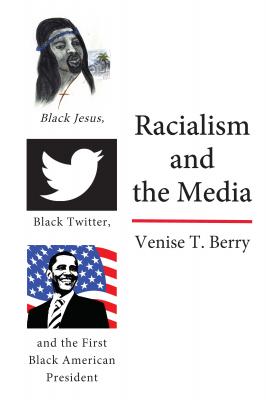ТОП просматриваемых книг сайта:
Racialism and the Media. Venise T. Berry
Читать онлайн.Название Racialism and the Media
Год выпуска 0
isbn 9781433172915
Автор произведения Venise T. Berry
Жанр История
Серия Black Studies and Critical Thinking
Издательство Ingram
Venise T. Berry
Racialism and the Media
Black Jesus, Black Twitter,
and the First Black
American President
Library of Congress Cataloging-in-Publication Data
Names: Berry, Venise T., author.
Title: Racialism and the media: Black Jesus, Black Twitter, and the
first Black American president / Venise T. Berry.
Description: New York: Peter Lang Publishing, 2020.
Series: Black studies and critical thinking, vol. 114 | ISSN 1947-5985
Includes bibliographical references and index.
Identifiers: LCCN 2019033891 | ISBN 978-1-4331-7289-2 (hardback: alk. paper)
ISBN 978-1-4331-7288-5 (paperback: alk. paper) | ISBN 978-1-4331-7290-8 (ebook pdf)
ISBN 978-1-4331-7291-5 (epub) | ISBN 978-1-4331-7292-2 (mobi)
Subjects: LCSH: African Americans and mass media. | Race in mass media. |
Race relations in mass media. | Mass media and race relations—
United States—History—21st century.
Classification: LCC P94.5.A37 B47 | DDC 305.896/073—dc23
LC record available at https://lccn.loc.gov/2019033891
DOI 10.3726/b16689
Bibliographic information published by Die Deutsche Nationalbibliothek.
Die Deutsche Nationalbibliothek lists this publication in the “Deutsche
Nationalbibliografie”; detailed bibliographic data are available
on the Internet at http://dnb.d-nb.de/.
© 2020 Venise T. Berry
Peter Lang Publishing, Inc., New York
29 Broadway, 18th floor, New York, NY 10006
All rights reserved.
Reprint or reproduction, even partially, in all forms such as microfilm,
xerography, microfiche, microcard, and offset strictly prohibited.
About the author
Venise T. Berry is an Associate Professor in African American Studies and Journalism at the University of Iowa in Iowa City. Her professional media career began in radio news but has expanded into teaching, media research and criticism, as well as fiction and non-fiction writing. She is published widely in academic circles with numerous journal articles based on her research in the area of media, African Americans and pop culture. To learn more visit: www.veniseberry.com.
About the book
Racialism and Media: Black Jesus, Black Twitter and the First Black American President is an exploration of how the nature of racial ideology has changed in our society. Yes, there are still ugly racists who push uglier racism, but there are also popular constructions of race routinely woven into mediated images and messages. This book examines selected exemplars of racialism moving beyond traditional racism. In the twenty-first century, we need a more nuanced understanding of racial constructions. Denouncing anything and everything problematic as racist or racism simply does not work, especially if we want to move toward a real solution to America’s race problems. Racialism involves images and messages that are produced, distributed, and consumed repetitively and intertextually based on stereotypes, biased framing, and historical myths about African American culture. These images and messages are eventually normalized through the media, ultimately shaping and influencing societal ideology and behavior. Through the lens of critical race theory these chapters examine issues of intersectionality in Crash, changing Black identity in Black-ish, the balancing of stereotypes in prime-time TV’s Black male and female roles, the power of Black images and messages in advertising, the cultural wealth offered through the Black Twitter platform, biased media framing of the first Black American president, the satirical parody of Black Jesus, contemporary Zip Coon stereotypes in film, the popularity of ghettofabulous black culture, and, finally, the evolution of black representation in science fiction.
This eBook can be cited
This edition of the eBook can be cited. To enable this we have marked the start and end of a page. In cases where a word straddles a page break, the marker is placed inside the word at exactly the same position as in the physical book. This means that occasionally a word might be bifurcated by this marker.
Table of Contents
Introduction: Racialism and the Media
Chapter One: Contemporary Zip Coons: The Problem with Funny
Chapter Two: Ghettofabulous: How Low Can You Go?
Chapter Three: Advertising and Black Folks: Whassup?
Chapter Four: Black-ish and the Changing Nature of Black Identity
Chapter Five: Balancing Stereotypes: Black Male and Female Roles on Prime-Time Television
Chapter Six: A Satirical Parody: Black Jesus in the Hood
Chapter Seven: Deconstructing Intersectionality in Crash
Chapter Eight: Black Twitter, Interpretive Communities, and Cultural Capital
Chapter Nine: President Barack Obama: Biased Frames and Microaggressions
Chapter Ten: Science Fiction and Fantasy: Going Where Few Blacks Have Gone Before
About the Author
Index
Figure I.1: King Kong “Destroy this mad brute” WWII recruitment poster
Figure 3.1: Kool-Aid “Old School Flavor” basketball stereotype
Figure 3.2: Dunkin Donuts “Charcoal Donut” ad in Thailand
Figure 3.3: Cheerios “Interracial family” Super Bowl commercial
Figure 3.4: Gerber “Earn your masters in chewing” placement status
Figure 3.5: Pine Sol “Intensity” reframing the mammy stereotype
This book is the result of twenty-five years of experiencing, teaching, and researching black images and messages in the

